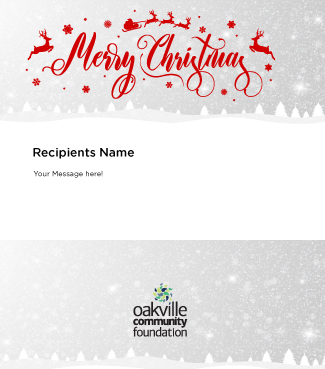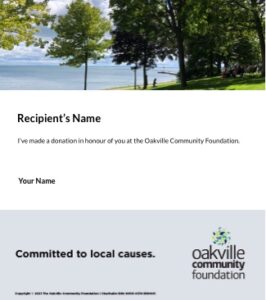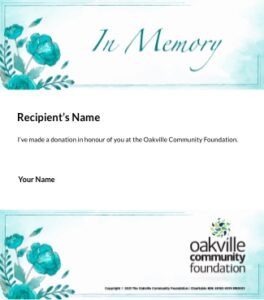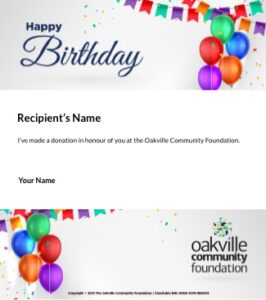Welcome back to the #WeekendReads series! On periodic Fridays throughout the year, the Oakville Community Foundation will share reports, data and information to help you stay informed when it comes to the community, the charitable sector and more. Click here for previous installments.
Throughout the year, Statistics Canada is releasing data gleaned from the 2021 Census that will show trends, anomalies and interesting bits of data that can then help to inform our work. The previous 2016 Census has already informed many of our research reports, which can be read here.
The most recent data released included a portrait of Canadian families, Canadian military experience and an income profile of Canadians. Income information plays a big part in many of the research reports that The Foundation produces, particularly when looking at low income populations.
Sources can be found here.
Youth
In the 2018 Vital Youth Report: A Tale of Two Childhoods, the first item on the Watchlist was: “Addressing child poverty in our communities.”
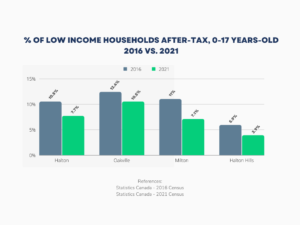 We know these statistics are familiar to you: based on 2016 Census data, 1 in 10 children and youth (10.5%) aged 0-17 in Oakville was considered to be low income, based on the low-income measure, after-tax. This number was even higher in Oakville, with 1 in 8 children and youth (12.4%) aged 0-17 living in poverty.
We know these statistics are familiar to you: based on 2016 Census data, 1 in 10 children and youth (10.5%) aged 0-17 in Oakville was considered to be low income, based on the low-income measure, after-tax. This number was even higher in Oakville, with 1 in 8 children and youth (12.4%) aged 0-17 living in poverty.
These numbers were concerning in our community, and unbelievable to some, as Oakville was and continues to be one of the wealthiest communities in the country.
As of the 2021 Census, these percentages have dropped considerably across the Region, with the biggest change being Milton. Milton went from 11% of children and youth 0-17 living in poverty to 7.1%, a 3.9% difference. This is undoubtedly a good thing, however we know that there are additional stressors that may still indicate precarious home environments.
Other differences include:
- Halton – 2.8% decrease
- Oakville – 1.9% decrease
- Halton Hills – 2% decrease
Older Adults
The 2021 Living Your Best Life: A Report on the Vitality of Older Adults in Our Community did a deep dive into how older adults are faring in our community. As of the 2016 Census, nearly 15% of the population in Halton was older than 65. This number has increased in the 2021 Census, with 16% of the population over 65-years-old.
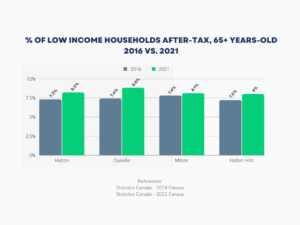 Most older adults are on fixed incomes and rely on their workplace pensions and private savings, as well as other benefits that are available to some older adults, particularly those living in poverty.
Most older adults are on fixed incomes and rely on their workplace pensions and private savings, as well as other benefits that are available to some older adults, particularly those living in poverty.
As of the 2016 Census, 7.3% of older adults 65+ in Halton and 7.4% of older adults 65+ in Oakville were living in poverty, based on the low-income measure, after-tax.
Unfortunately, as of the 2021 Census, these percentages have increased across the Region. The highest increase is in Oakville, at 1.4%, from 7.4% in 2016 to 8.8% in 2021.
Other differences include:
- Halton – 0.9% increase
- Milton – 0.3% increase
- Halton Hills – 0.8% increase
We also know that poverty rates increase as you age and are higher with women. In 2016, 8.8% of women in Halton Region were considered to be low income, which has increased to 9.6% of women in the Region.
What does this mean?
To continue supporting children and youth in our community, consider donating to our Community Classroom Fund which supports students in publicly-funded schools in Oakville, as well as Mississaugas of the Credit First Nation students at Lloyd S. King Elementary School, experience a local arts, culture, heritage or environment program for free.
Read through the entire 2021 Living Your Best Life: A Report on the Vitality of Older Adults in Our Community to learn more about older adults in our community as well as the charitable organizations that are doing their best to support these members of our community. For example, in 2021 The Foundation granted $32,000 to Rotary Oakville Trafalgar to bring Adult and Senior Fitness Equipment to Memorial Park. Read more here.
Keep checking back in the fall for more ways to support the most vulnerable in our community.
You might also be interested in:







